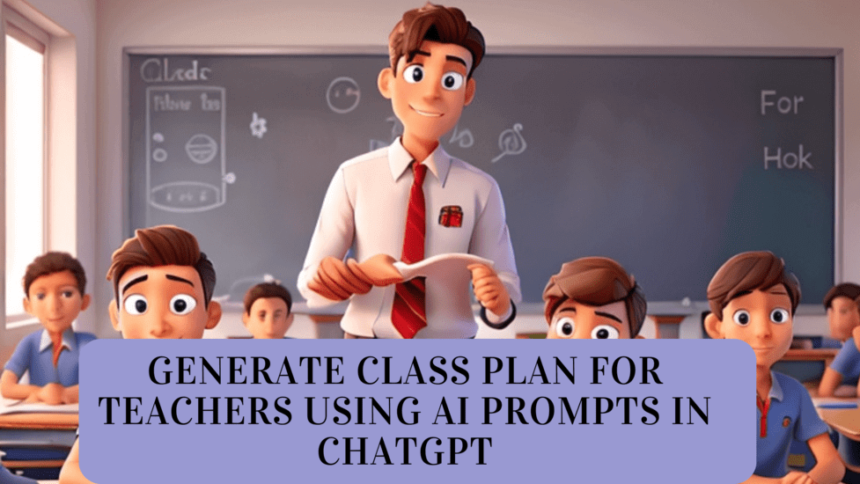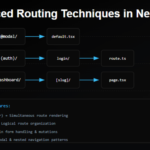Intro – Generate class plan for teachers using AI prompts in ChatGPT
Artificial Intelligence (AI) tools have emerged as powerful allies in the world of education, simplifying tasks and offering new possibilities. One such tool is ChatGPT, which can be harnessed to generate efficient class plans with ease. In this article, we will explore how teachers can use ChatGPT’s Class Plan Prompt to revolutionize their lesson-planning process and optimize their teaching strategies. Read on to discover the benefits and SEO keywords to help you rank this page.
Class Plan Template for Teachers
Copy and paste the below prompt in ChatGPT. Make sure you replace the placeholders.
You are an expert teacher and you have to generate a class plan using the below template
Subject: [Enter Subject]
Grade Level: [Enter Grade Level]
Date: [Enter Date]
Topic: [Enter Topic]
Lesson Plan:
Objective: In this lesson, students will [state the learning objective].
Materials Needed: [List materials and resources required for the lesson]
Introduction (5 minutes): Begin the lesson by [briefly describe how you will introduce the topic].
Main Activity (20 minutes): During this segment, students will [describe the main activity or activities].
Discussion (15 minutes): Engage students in a discussion about [key points or concepts related to the topic].
Assessment (10 minutes): Evaluate students' understanding through [mention the form of assessment, e.g., quiz, group project].
Conclusion (5 minutes): Summarize the key takeaways of the lesson and provide any homework assignments or follow-up activities.Example 1: Generate a class plan for the topic “Introduction to Fractions”
You are an expert teacher and you have to generate a class plan using the below template
Subject: Mathematics
Grade Level: 6th Grade
Date: September 25, 2023
Topic: Introduction to Fractions
Lesson Plan:
Objective: In this lesson, students will understand the concept of fractions and be able to represent and compare fractions.
Materials Needed: Whiteboard, markers, fraction manipulatives, worksheets.
Introduction (5 minutes): Begin the lesson by showing a pizza divided into slices and asking students how they would represent the portion of the pizza they want to eat.
Main Activity (20 minutes): During this segment, students will use fraction manipulatives to represent and compare fractions. They will work in pairs to complete fraction worksheets.
Discussion (15 minutes): Engage students in a discussion about equivalent fractions and how to compare fractions with different denominators. Use examples on the whiteboard.
Assessment (10 minutes): Distribute a fraction quiz with multiple-choice and short-answer questions to assess students' understanding.
Conclusion (5 minutes): Summarize the key takeaways of the lesson, assign homework to practice fractions, and remind students of the next class.Output of the AI prompt in ChatGPT
Class Plan
Subject: Mathematics
Grade Level: 6th Grade
Date: September 25, 2023
Topic: Introduction to Fractions
Lesson Plan:
Objective: In this lesson, students will understand the concept of fractions and be able to represent and compare fractions.
Materials Needed: Whiteboard, markers, fraction manipulatives (e.g., fraction circles or strips), worksheets, fraction quiz, projector (optional for displaying worksheets and examples).
Duration: 60 minutes
Teaching Method: Interactive and hands-on learning.
Introduction (5 minutes):
Begin the lesson by welcoming students and establishing the learning objectives for the day.
Show an image or drawing of a pizza divided into slices and ask students how they would represent the portion of the pizza they want to eat.
Elicit responses and write down key ideas on the whiteboard to introduce the concept of fractions.
Main Activity (20 minutes):
Divide the class into pairs.
Distribute fraction manipulatives (fraction circles or strips) to each pair.
Provide each pair with fraction worksheets that include activities like shading fractions of shapes, comparing fractions, and identifying equivalent fractions.
Encourage students to use the manipulatives to solve the problems on their worksheets.
Circulate around the classroom to provide assistance and monitor progress.
After completion, bring the class back together for a brief discussion of their findings and experiences.
Discussion (15 minutes):
Initiate a discussion about equivalent fractions and how to compare fractions with different denominators.
Use the whiteboard to illustrate examples, such as comparing 1/2 and 2/4 or finding equivalent fractions for 1/3.
Engage students in analyzing the patterns and relationships between fractions.
Encourage students to ask questions and share their thoughts.
Assessment (10 minutes):
Distribute the fraction quiz with a mix of multiple-choice and short-answer questions.
Ask students to complete the quiz individually.
Collect the quizzes for grading, or if time allows, review some of the questions as a class to ensure understanding.
Conclusion (5 minutes):
Summarize the key takeaways of the lesson, emphasizing the importance of understanding fractions in everyday life.
Assign homework that reinforces the concepts covered in the lesson. For example, students could practice comparing fractions or finding equivalent fractions.
Remind students of the date and topic for the next class, encouraging them to come prepared.
Homework Assignment:
Practice comparing fractions and finding equivalent fractions. Provide a set of practice problems for homework to reinforce the concepts learned in class.
Additional Notes:
Be attentive to students who may require extra support and provide additional guidance as needed.
Use real-life examples, such as sharing food, to make the concept of fractions relatable to students.
Encourage a positive and supportive classroom environment where students feel comfortable asking questions and participating in discussions.
Utilize technology (e.g., a projector or interactive whiteboard) to display examples and worksheets for better visibility if available.Example2: Generate a class plan for the topic “USA history”
You are an expert teacher and you have to generate a class plan using the below template
Subject: U.S. History
Grade Level: 8th Grade
Date: October 12, 2023
Topic: The American Civil War
Lesson Plan:
Objective: In this lesson, students will understand the causes, key events, and consequences of the American Civil War.
Materials Needed:
Textbooks
Maps of Civil War battles
Primary source documents (letters, diaries)
Whiteboard and markers
Handouts with questions
Introduction (5 minutes): Begin the lesson by asking students to brainstorm what they already know about the American Civil War. Write their responses on the whiteboard.
Main Activity (20 minutes):
Provide an overview of the causes of the Civil War.
Divide the class into groups and distribute primary source documents related to the Civil War. Ask each group to analyze the documents and discuss their findings.
Use maps to show the major battles and territories involved in the war.
Discussion (15 minutes): Engage students in a discussion about the significance of the Civil War in shaping the United States. Encourage them to share their insights from analyzing the primary source documents.
Assessment (10 minutes): Distribute a worksheet with multiple-choice and short-answer questions about the causes and consequences of the Civil War. Collect and review the worksheets to assess understanding.
Conclusion (5 minutes): Summarize the key points of the lesson, emphasizing the importance of understanding the Civil War's impact on American history. Assign reading from the textbook and a short essay as homework to explore a specific aspect of the Civil War in more depth.💁 Check out our other articles😃
Mastering JavaScript: 50 JavaScript Code Snippets for Web Developers
Comprehensive Guide to Marketing Any Digital Product using AI Prompts
Pro Tip
If you are too lazy to fill the placeholders then You can copy past just the template by just replacing the [subject] and asking ChatGpt to generate the complete class plan
You are an expert teacher and you have to generate a class plan using the below template and give me an example for study of [subject]
Subject: [Enter Subject]
Grade Level: [Enter Grade Level]
Date: [Enter Date]
Topic: [Enter Topic]
Lesson Plan:
Objective: In this lesson, students will [state the learning objective].
Materials Needed: [List materials and resources required for the lesson]
Introduction (5 minutes): Begin the lesson by [briefly describe how you will introduce the topic].
Main Activity (20 minutes): During this segment, students will [describe the main activity or activities].
Discussion (15 minutes): Engage students in a discussion about [key points or concepts related to the topic].
Assessment (10 minutes): Evaluate students' understanding through [mention the form of assessment, e.g., quiz, group project].
Conclusion (5 minutes): Summarize the key takeaways of the lesson and provide any homework assignments or follow-up activities.The above prompt generated below class plan
Subject: Life Science
Grade Level: 4th Grade
Date: October 10, 2023
Topic: Study of Ants
Lesson Plan:
Objective: In this lesson, students will explore the fascinating world of ants, understand their behavior, and appreciate their importance in ecosystems.
Materials Needed:
Ant farm or ant observation setup (if available)
Magnifying glasses
Pictures or diagrams of different ant species
Whiteboard and markers
Notebooks or worksheets for students
Video clips or books about ants (optional)
Introduction (5 minutes):
Begin the lesson by showing a picture of a busy ant colony on the whiteboard.
Ask students what they know about ants and what questions they have about these insects.
Briefly explain that today, they will learn about the study of ants and why ants are essential to our environment.
Main Activity (20 minutes):
Show students an ant farm or an ant observation setup if available. If not, use pictures or videos to depict an ant colony.
Provide magnifying glasses for students to examine ants up close.
Encourage students to observe the ants' behavior, such as how they work together, how they collect food, and how they build tunnels.
Have students take notes in their notebooks or on worksheets, documenting their observations and questions.
Discussion (15 minutes):
Engage students in a discussion about the role of ants in the ecosystem. Discuss key points such as:
Ants as decomposers, breaking down dead plant and animal matter.
Ants as pollinators and seed dispersers.
Ants' social structure, including the roles of workers, soldiers, and the queen.
Ants' communication methods, such as chemical signals and pheromones.
Encourage students to share their observations and questions from the main activity.
Assessment (10 minutes):
Conduct a group activity where students work together to create a simple diagram or poster that illustrates the different roles of ants in an ecosystem.
Have each group present their poster to the class, explaining their understanding of ants' importance.
Alternatively, assign a short written reflection or drawing activity where students can showcase what they've learned about ants.
Conclusion (5 minutes):
Summarize the key takeaways of the lesson, emphasizing the importance of ants in nature.
Assign homework for students to continue their exploration of ants, such as researching a specific ant species or keeping a journal of ant observations in their backyard.
Provide additional resources or recommend books for students who want to learn more about ants.
Homework Assignment:
Research a specific ant species (e.g., leafcutter ants or army ants) and create a poster or presentation highlighting their unique characteristics, behaviors, and ecological roles.Conclusion
ChatGPT’s Class Plan Prompt is a valuable tool for teachers seeking efficiency, customization, consistency, and adaptability in their lesson planning. By harnessing the power of AI, educators can streamline the planning process, allowing them to focus more on teaching and nurturing their students’ growth.









